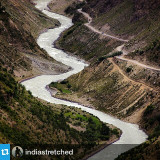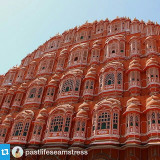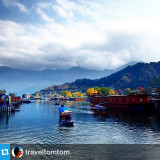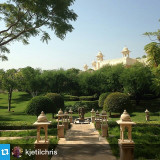Random image from our India photo collection

Delhi
History
It is believed that Delhi, then known as Indraprashtha, was the land of action of India’s great epic, the Mahabharata. Periodic archeological excavations bring in more and more evidence to support this contention.
Recorded history exists from the 11th century when Dillika, as this little town was known, found its focal point south of where it is now. This kingdom was known as Lal Kot. The famous ruler of this line of Tomars was called Prithvi Raj Chauhan. He is said to have built many temples and a huge fort called Qila Rai Pithora.
However, their 200-year-old rule came to an end with the arrival of the Slave Dynasty. One of the rulers of this dynasty, Qutub-ud-din Aibak, built the tall Qutab Minar. The Qutab Minar has five floors. It is 72.55-m high with a base diameter of 14.40 tapering to 2.4 m at the top.
Time moved on and by the end of the 13th century, the Khilji Dynasty was looking around for the best piece of land on which to build their seat of empire.
Ghiyasuddin Tughlaq succeeded Alauddin Khilji and, as pride demanded, built a magnificent fort at Tughlaqabad. It is perhaps the most beautiful ruin in the country.
Standing very tall, its massive structure is quite contrasting to the delicate ornate style, but it is still charming. The famous traveler Ibn Batuta stated that it used to shine bright against the sun like a fort made of gold. There were huge silos at the entry points and this fort had many gates. A saint called Nizammuddin Aulia cursed Ghiyasuddin Tughlaq that his city would never flourish.
And in the coming years Ghiyasuddin, fell prey to his son Mohammad Bin Tughlaq. Mohammad built his own city, Adilabad, a few yards away from Tughlaqabad. He enclosed a large area within a wall, creating within it the Jahanpanah forest.
His nephew was Ferozshah Tughlaq. The fort built by Ferozshah—known as Ferozshah Kotla has stood as an inspiring backdrop to many famous bowlers and batsmen. This fifth city, like the sixth city of the Lodi Dynasty, has few of its monuments left.
However, it did not last long. This time the famous battle of Panipat, which brought the hinge back to Delhi eventually, saw Sher Shah Suri as the ruler. Sher Shah laid the foundation for the Grand Trunk Road and built the Old Fort. Today the fort complex houses the zoo in addition to preserving some of the buildings inside the fort.
The living legacy of Delhi is Shahjahanabad. Created by the builder of Taj Mahal, this city, with the Red Fort as the focal point and Jama Masjid as the praying center, has a fascinating market planned to shine under the light of the moon, called Chandni Chowk. Shahjahan planned Chandni Chowk so that his daughter could shop for all that she wanted. It was divided by canals filled with water, which glistened like silver in moonlight. The canals are now closed, but Chandni Chowk remains Asia’s largest wholesale market. Crafts, once patronized by the Mughals continue to flourish in the small lanes of the city, once known as Shahjahanabad.
Modern Delhi, or New Delhi as it is called, centers around Rashtrapati Bhawan. It is architecturally a very impressive building standing at a height, flowing down as it were to India Gate. This stretch is called the Rajpath and it is where the Republic Day parade is held.
Delhi remains the center of power. Once it was a city of royal power. Then it became the seat of colonial power. Later it was the seat of bureaucratic power. The seat of political power it has always been. Today it is emerging as an important center for corporate power too.
The most fascinating aspect of this city is its cosmopolitan nature. You can find the whole of India in Delhi’s little colonies and structures.
Go back
Recorded history exists from the 11th century when Dillika, as this little town was known, found its focal point south of where it is now. This kingdom was known as Lal Kot. The famous ruler of this line of Tomars was called Prithvi Raj Chauhan. He is said to have built many temples and a huge fort called Qila Rai Pithora.
However, their 200-year-old rule came to an end with the arrival of the Slave Dynasty. One of the rulers of this dynasty, Qutub-ud-din Aibak, built the tall Qutab Minar. The Qutab Minar has five floors. It is 72.55-m high with a base diameter of 14.40 tapering to 2.4 m at the top.
Time moved on and by the end of the 13th century, the Khilji Dynasty was looking around for the best piece of land on which to build their seat of empire.
Ghiyasuddin Tughlaq succeeded Alauddin Khilji and, as pride demanded, built a magnificent fort at Tughlaqabad. It is perhaps the most beautiful ruin in the country.
Standing very tall, its massive structure is quite contrasting to the delicate ornate style, but it is still charming. The famous traveler Ibn Batuta stated that it used to shine bright against the sun like a fort made of gold. There were huge silos at the entry points and this fort had many gates. A saint called Nizammuddin Aulia cursed Ghiyasuddin Tughlaq that his city would never flourish.
And in the coming years Ghiyasuddin, fell prey to his son Mohammad Bin Tughlaq. Mohammad built his own city, Adilabad, a few yards away from Tughlaqabad. He enclosed a large area within a wall, creating within it the Jahanpanah forest.
His nephew was Ferozshah Tughlaq. The fort built by Ferozshah—known as Ferozshah Kotla has stood as an inspiring backdrop to many famous bowlers and batsmen. This fifth city, like the sixth city of the Lodi Dynasty, has few of its monuments left.
However, it did not last long. This time the famous battle of Panipat, which brought the hinge back to Delhi eventually, saw Sher Shah Suri as the ruler. Sher Shah laid the foundation for the Grand Trunk Road and built the Old Fort. Today the fort complex houses the zoo in addition to preserving some of the buildings inside the fort.
The living legacy of Delhi is Shahjahanabad. Created by the builder of Taj Mahal, this city, with the Red Fort as the focal point and Jama Masjid as the praying center, has a fascinating market planned to shine under the light of the moon, called Chandni Chowk. Shahjahan planned Chandni Chowk so that his daughter could shop for all that she wanted. It was divided by canals filled with water, which glistened like silver in moonlight. The canals are now closed, but Chandni Chowk remains Asia’s largest wholesale market. Crafts, once patronized by the Mughals continue to flourish in the small lanes of the city, once known as Shahjahanabad.
Modern Delhi, or New Delhi as it is called, centers around Rashtrapati Bhawan. It is architecturally a very impressive building standing at a height, flowing down as it were to India Gate. This stretch is called the Rajpath and it is where the Republic Day parade is held.
Delhi remains the center of power. Once it was a city of royal power. Then it became the seat of colonial power. Later it was the seat of bureaucratic power. The seat of political power it has always been. Today it is emerging as an important center for corporate power too.
The most fascinating aspect of this city is its cosmopolitan nature. You can find the whole of India in Delhi’s little colonies and structures.
Go back









